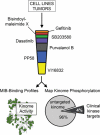The dynamic nature of the kinome
- PMID: 23343193
- PMCID: PMC3808244
- DOI: 10.1042/BJ20121456
The dynamic nature of the kinome
Abstract
Recent advances in proteomics have facilitated the analysis of the kinome 'en masse'. What these studies have revealed is a surprisingly dynamic network of kinase responses to highly selective kinase inhibitors, thereby illustrating the complex biological responses to these small molecules. Moreover these studies have identified key transcription factors, such as c-Myc and FOXO (forkhead box O), that play pivotal roles in kinome reprogramming in cancer cells. Since many kinase inhibitors fail despite a high efficacy of blocking their intended targets, elucidating kinome changes at a more global level will be essential to understanding the mechanisms of kinase inhibitor pharmacology. The development of technologies to study the kinome, as well as examples of kinome resilience and reprogramming, will be discussed in the present review.
Figures


References
Publication types
MeSH terms
Substances
Grants and funding
LinkOut - more resources
Full Text Sources
Other Literature Sources
Research Materials

